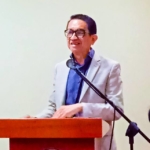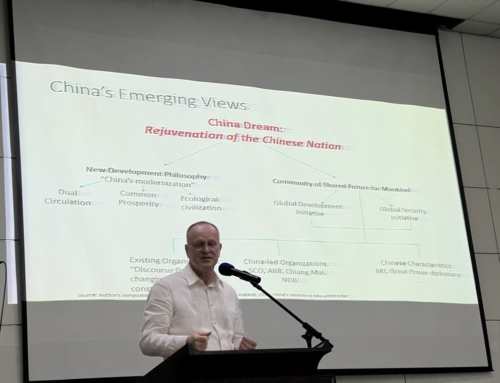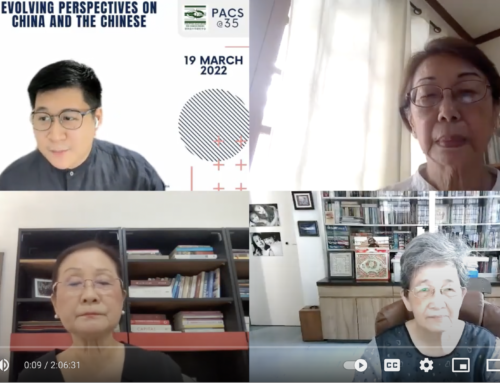Skip to content
China’s rise, new immigrants (新桥): Impact on the Philippines
by Rommel C. Banlaoi, PhD
In the past decade, Filipinos have witnessed the massive influx of Chinese nationals to the Philippines. This has coincided with the phenomenal rise of China as a global economic power. From January 2016 to May 2018, the Bureau of Immigration reported a total of 3.12 million Chinese citizens who arrived to the Philippines. More than 70% or 2.4 million of these Chinese visitors came from Mainland China while the rest came from Hong Kong, Macau, and Taiwan.
When President Rodrigo Duterte made a game-changing paradigm shift to China as part of the government’s independent foreign policy, the Philippines became one of the most favored destinations of Chinese nationals. In 2017 alone, a total of 1.38 million Chinese nationals came to the Philippines compared to 1.02 million in 2016 based on official government figures. During the first six months of 2018, around 800,000 Chinese nationals arrived to the Philippines. If this trend continues, an estimated 1.6 million Chinese nationals are expected to arrive for the whole year of 2018.
What brings/attracts Chinese nationals to come to the Philippines in the past decade? What are the new government policies on migrants (huaqiao), the ethnic Chinese (huayi)? What is the impact of the overseas Chinese/new Chinese migrants in the domestic economy? What are the possible consequences of treating the Chinese as a homogeneous group regardless of ethnicity and citizenship? What are the positive and the adverse impact of the rise of China on ethnic Chinese communities, on the Chinese nationals, on the perception of the mainstream society about China and the Chinese?
To address all these questions, the Philippine Association for Chinese Studies (PACS) organized the Focus Group Discussion (FGD) on 4 September 2018 at the Xavier School with diverse group of participants from the academe, government, and the private sectors. Father Aristotle Dy, Xavier School President and PACS Vice President, hosted the FGD.
Teresita Ang See, Founding President of Kaisa Para sa Kaunlaran, Inc. and former President of PACS, opened the FGD with a presentation on “The Rise of China and Changing Policies on Chinese Overseas”. Ang See emphasized that beyond maritime disputes in the South China Sea, there are pressing problems in Philippines-China relations needing appropriate actions by all parties concerned. One of these problems is associated with the influx of new Chinese immigrants to the Philippines.
The presence of new Chinese immigrants to the Philippines is strongly indicated by the proliferation of chambers of commerce and associations organized by them. Ang See enumerated some of them like the Philippine China Chambers of Commerce, Migrant Chinese Chamber of Commerce and Industry of the Philippines Junior Chinese Chamber of Commerce, Filipino-Chinese Friendship Association, and Filipino-Chinese Shin-Lian Association. The construction of Philippines-China Friendship Arch in Quezon City in 2014, China Friendship Arch in Manila in 2015 and similar arches in Iloilo and Davao City also symbolizes the growing presence of new Chinese immigrants to the country.
While some new Chinese immigrants have found good fortune through peaceful commerce and trade, others have suffered hardships due to fraudulent circumstances. Overseas Chinese workers to the Philippines are oftentimes victims of criminal syndicates engaged in “get-rich-quick schemes”, drug trafficking, smuggling of goods and humans, kidnapping, and even ransom payments from the illegal practice of the Philippine government’s crackdown against illegal drugs. To attract Chinese nationals to continue coming to the Philippines despite some reported hardships and maltreatment from fellow Chinese nationals, Ang See underscored the use of false advertisements with a too-good-to-be-true offer of anything the Chinese immigrants need: from ready-to-use bank and credit cards, immigration assistance, condominium units and even services of guest relations officers (GROs), a euphemism for prostitutes.
To discuss the economic ramifications of the rise of China in relation with the issue of new Chinese immigrants to the Philippines, Dr. Federico Macaranas, Adjunct Faculty of the Asian Institute of Management (AIM) emphasized the need to understand beyond events on the rise of China and Philippines-China relations. He said that media could cover events. But the academe must discover the pattern arising these events.
Macaranas stressed that to be useful for policy developments, scholars and enthusiasts must be able to grasp the over-all structure (economic, social, cultural, political) of the rise of China and Philippines-China relations. The main task, therefore, for scholars is to find out how overseas Chinese could relate to these big structures, patterns and events. Patterns and events may change over-time. But structures will always be there as human beings. Both the new and old Chinese overseas or communities exist in these economic, social, cultural and political structures. Thus, we need to look at the Chinese people not as enemies based on reportage of events but as products of structures in which they find themselves.
Understanding these structures can provide a more nuanced understanding of the current behavior of old and new Chinese overseas amidst the rise of China, which is the new China. But the new China is still informed by the old Chinese civilization when it relates to the outside. This civilization describes China not as a country that has the intention to colonize but as a nation that only wants to trade based on Confucian tradition. Thus, China can become the new power if it behaves according to the old Chinese civilization of the Confucian society. Otherwise, China will behave like other major powers that are just hungry for economic power.
Describing the Philippine labor policy towards overseas Chinese workers to the Philippines, Ms. Cheryl Pisigan from the Department of Labor and Employment (DOLE) reported that from January 2016 to May 2018, DOLE issued 53,111 Chinese nationals their Alien Employment Permits (AEP). Around 60% or 32,032 received employment at the National Capital Region (NCR) mostly in Administrative and Support Services Activities (ASSA) for casinos and gaming industries. Around 20% or 10,560 Chinese nationals received AEPs to work in Arts, Entertainment and Recreation (AER) activities while 14% or 7,754 Chinese nationals got their AEPs to work in Information and Communication (IC) industry. The remaining 6% found work in other industries.
During the discussions, a participant from the private sector said that the official figure was in fact three times lower that the actual figure of Chinese nationals working in the Philippines, particularly in Metro Manila. Based on private sector estimate, there could be more than 53,000 Chinese nationals working in the Philippines if others who received Special Working Permit (SWP) issued by the Bureau of Immigration would be counted.
Chinese nationals preferred to apply for SWP than AEP because the process was easier. The only problem with SWP was the period of employment of three months compared to AEP with a period of employment of six months. Chinese overseas workers just applied for renewal of their SWPs to stay longer. If we consider those Chinese nationals receiving SWPs, the number could reach 150,000 to 200,0000. Thus, prices of real property units soared high in Metro Manila because of high demands for more units coming from Chinese overseas workers.
Representative from the Bureau of Immigration (BI) confirmed that the bureau has issued SWPs to Chinese nationals to work mostly in ASSA and AER. Chinese nationals opted for SWPs because of fewer requirements and less fees due to shorter period of employment of three months. SWPs can be renewed for another three months if workers wanted to stay longer. But the private sector participant raised the issue of exorbitant fees for SWPs. The BI representative said that the application for issuance of SWPs would be cheaper if Chinese workers would apply directly to BI and not through the agency or broker.
One of the unintended consequences of the influx of Chinese nationals to the Philippines is the involvement of some of them in illegal drug trade. According to PCSupt. Albert Ignatius Ferro, Director of the Drugs Enforcement Group (DEG) of the Philippine National Police (PNP), there are three types of syndicates involved in illegal drug trade in the Philippines: the Chinese/Filipino-Chinese-Taiwanese Drug Syndicate, the African Drug Syndicate, and the Mexican Sinaloa-Chinese Filipino Drug Syndicate. Ferro lamented that the Chinese/Filipino-Chinese-Taiwanese Drug Syndicate currently dominates illegal drug activities in the country. This drug syndicate uses hotels and casinos as their main areas of big trade.
Historically, Ferro noted that the overseas Chinese introduced illegal drug in the Philippines through the use of opium. At present, China is the major source of methamphetamine (shabu) entering the Philippines. Since the Philippine government launched its war on drugs in 2016, some Chinese nationals have been arrested and jailed. However, a few of those jailed have used prisons to continue illegal drug trade. Ferro underscored that at present, the Philippines and China have a very strong cooperation against illegal drugs in terms of law enforcement exchanges, sharing of information, and capacity building.
During the discussion, one participant raised the use of marijuana for medical purposes. A few Chinese Filipinos, particularly the older ones, have used marijuana to cure illness. Ferro recognized the move of some sectors to legalize the medical use of marijuana. However, he cautioned the possibility of abuse. So, he personally discouraged the use of marijuana for medical use and urged patients to explore other medical options to cure their illnesses.
The FGD generated many insights on the topic. During the discussions, participants mentioned variety of reasons why Chinese nationals come to the Philippines: business, tourism, education, employment, and permanent settlement. In a basket however, there are always bad apples. There have been a few Chinese nationals in the Philippines involved in illegal activities like drug trafficking, human smuggling, smuggling of commodities, and most recently kidnapping of Chinese nationals involved in gambling. The involvement of a few Chinese nationals in illegal activities creates law enforcement problems in the Philippines that if not solved can affect Philippines-China relations in the long run.
But as Mr. Austin Ong from Integrated Development Studies Institute said during the discussion, if everybody would look at the bad apples, this would prevent us from benefiting from the rest of the good fruits in the basket. The average income of Chinese nationals working in the Philippines is P30,000 to P60,000 per month. Their presence alone generates economic activities in the country in terms of rent of real properties, purchase of goods, and even hiring of services of Filipino domestic workers. Thus, aside from the economic benefits from Chinese investments in the Philippines, entry of Chinese nationals for employment in the country has economic multiplier effects that can provide good benefits for the Philippine economy.
There is no doubt that the rise of China as a global economic power has encouraged Chinese nationals to also go overseas for business, trade, tourism, and employment. Some go overseas to immigrate and settle in a foreign shore. The Philippines has become one of the major destinations of Chinese nationals for this variety of reasons.
However, involvements of a few Chinese nationals in unscrupulous and fraudulent activities in the Philippines are serious concerns that can affect Philippines-China relations. The FGD candidly tackled these concerns to raise vigilance and call to action. The major take away from the FGD is the fact that Philippines-China relation is not defined by the territorial disputes in the South China Sea but by a wide array of issues like the phenomenon of new Chinese overseas to the Philippines. As Ang See argued in her presentation, this situation should require all concerned government agencies to work together in order to continue attracting Chinese nationals to come to the Philippine for tourism and business purposes but discouraging unscrupulous individuals to enter the country for criminal reasons. Ang See also urged the Chinese embassy to the Philippines to assign permanent legal practitioners, law enforcement officers and even interpreters to help and protect Chinese nationals in trouble.
In conclusion, the presence of overseas Chinese and new Chinese migrants to the Philippines generates more positive rather than negative effects on domestic Philippine economy. Their presence also generates positive and negative social, cultural, and political repercussions. The main challenge for both scholars and policy makers is to identify ways on how to overcome its negative repercussions and take advantage of its positive effects in order to sustain and enhance Philippines-China relations.
PACS2019-07-22T10:14:00+00:00
Share This Story, Choose Your Platform!













